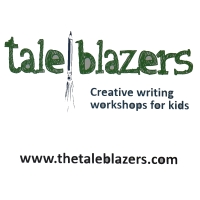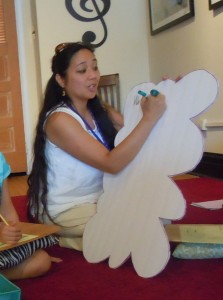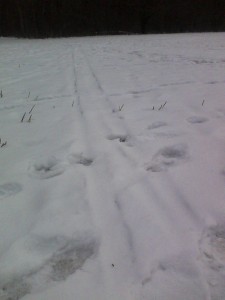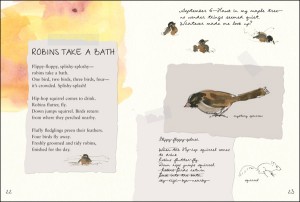Getting a late start today – it was good to sleep in a little. So many distractions. The sun is out and the fall earth smells good. The cafe is noisy and filled with crying kids. My dog needs walking. I’m buzzing with static. LOL. This is just how it is sometimes. Some days for writers, I think it’s just about showing up on the Page. SHOW UP! (Or blog about NaNoWriMo process – the best distraction of all.)
Author Archives: Mary Grace Bertulfo
NaNoWriMo – Getting passed head static
It’s day 3 of Nanowrimo. 5,880 words total so far. (Making time because who knows how much I can write over Thanksgiving travels.) Today, I wrote my big battle scene – the one that has me scared and shaking in my boots. How does a pacifist write a battle scene? LOL. Well…all I can say is there’s something to doing the very thing that scares you the most. I have a tremendous sense of accomplishment having written a first draft of this scene, flaws and all. It was also totally useful to put a writing soundtrack on…so I could stop thinking and analyzing and get passed the distracting static in my head. Today’s soundtrack: Grace Nono’s Dalit. (Dalit means gift or offering.) Strong, spiritual, sensual, earthy and devoted to Pinay traditions. Would love to be like her when I grow up!
NaNoWriMo 2011
This year, I’m doing NaNoWriMo for the first time – for both the fun and the discipline. Woke up this morning at 6 a.m. and wrote 3,800 words. So happy. Is there such a genre as eco-historical fiction with a supernatural twist? Like a martini with coconut and lime.
– M.G.
Taleblazers, creative writing workshops for kids
It has been a fun and busy summer. I taught 4 creative writing classes for kids in the vibrant Oak Park Arts District Summer Camp. It was a joyous time! My favorite moments: Seeing one student gripped by her imagination and shaking from the excitement of the Story that was unfolding on the Page. Helping one young writer realize first drafts can be messy – very liberating. Listening to my five, six, and seven year old students play djembe and xylophone and read a poem full of sound words (onomatopoeia) they had invented. Zimbitty-zimbitty! Boom-boom!
The wild ride continues this fall. From Oct 1 – Nov 19, I’m offering a Taleblazers class called Audacious Authors (Ages 7-11), a facilitated writing group for kids who love writing. Saturdays, 2:15 – 3:45 p.m. Writing games, skits, role-plays, and examples of how professional writers play with and edit their own pieces. Encouragement, fun, and a gentle approach. Kids can come scribble & play with words! It’s a supportive way for young authors to stretch their wings. For more info and to register, go to www.thetaleblazers.com
Questions? Drop me an email at: msmg@thetaleblazers.com. Or ring me at: (708) 317-TALE.
With joy,
Mary Grace
(aka Ms. M.G.)
Art + Nature: Lyrebird Ensemble Interview
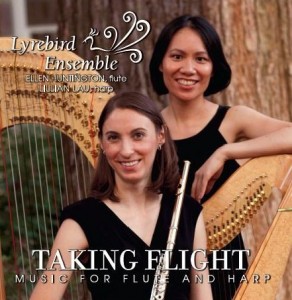 Harpist Lillian Lau and flutist Ellen Huntington are an elegant duo with a mission to reinvigorate interest in music composed specifically for harp and flute. Ellen is an award-winning Instructor of Flute at North Park University, a soloist, chamber musician teacher, and orchestral musician. Lillian is an orchestral musician, educator, solo harpist, and chamber recitalist who has performed with the Chicago Symphony Orchestra, the National Repertory Orchestra, at the Grant Park Music Festival, the Ravinia Festival and throughout Europe. Together, they are Lyrebird Ensemble.
Harpist Lillian Lau and flutist Ellen Huntington are an elegant duo with a mission to reinvigorate interest in music composed specifically for harp and flute. Ellen is an award-winning Instructor of Flute at North Park University, a soloist, chamber musician teacher, and orchestral musician. Lillian is an orchestral musician, educator, solo harpist, and chamber recitalist who has performed with the Chicago Symphony Orchestra, the National Repertory Orchestra, at the Grant Park Music Festival, the Ravinia Festival and throughout Europe. Together, they are Lyrebird Ensemble.
Lark-song greeting sunrises and sunsets. Wings swooping and gliding on the wind. A pounding Maori waterfall. Cascading rivulets. And water nymphs. Lyrebird Ensemble transports you to riverbank and sky on their debut album Taking Flight. The album is, in turns, playful and soothing. Check out Ellen and Lillian’s interview, music links, and join the Midwest’s celebration of spring’s return!
– Mary Grace
How did you arrive at your duo’s name?
Lillian: Lyrebirds are among Australia’s best-known native birds, most notable for their superb ability to mimic natural and artificial sounds from their environment. They are also known for their striking beauty when the male tail is fanned out in display.
Ellen: The name is appropriate since the lyre is precursor to the harp and birds in music are most often depicted by the flute.
Can you tell us what kind of flute and harp each of you plays?
Ellen: I play a handmade Miyazawa 14 carat gold flute with sterling silver keys. In fact, I am a “Miyazawa Artist”, a representative performer of this flute maker and I am featured on their website. Miyazawa flutes are made in Japan.
Lillian: I play a 47-string concert grand pedal harp made by Lyon & Healy of Chicago, IL. It is made from Birdseye Maple for the body of the instrument, and Sitka Spruce for the soundboard. The seven pedals connected to the mechanism make it possible to play technically challenging music.
Congratulations on your new CD, Taking Flight, Music for Flute and Harp. How did you choose the composers and songs for this album?
Ellen: Most flute and harp duos play a very small selection of repertoire, and a lot of that repertoire consists of transcriptions, or music originally written for other instruments. While I was doing my doctoral studies at Northwestern and deciding on a dissertation topic, I began compiling a list of works written specifically for flute and harp, and came up with over 800! Lillian and I read through over 100, identifying pieces that interested us. This is how we discovered the lesser-known works on the CD, by Bemberg, Grandval and Folprecht, and thought it would be great to record these pieces that most people have never heard. We decided to include the Alwyn and Farr since they are both beautiful and exciting, fit our 20th century theme, and, together with “The Song of the Lark”, gave a nature-inspired theme to the CD.
What does the album title, Taking Flight, mean?
Lillian: When the Lyrebird Ensemble was considering an appropriate album title, we wanted to capture the nature themes from the musical titles. Taking Flight is also a celebration of our debut recording. Hopefully, there will be more to come.
Ellen, can you tell us what role birds play on the Taking Flight CD?
The flute can be heard specifically imitating bird sounds in “The Song of the Lark”. Much of this piece is written without strict meter. In some sections, the harp provides an ostinato background over which the flute plays a free bird-like melody. The composer gives guidelines about the note lengths and phrasing, but the interpretation is mostly left to the performer.
The work by Alwyn was actually inspired by the idea of water nymphs, and the flute and harp often combine to create sounds that are flowing or rippling like water. There are also sections in this piece where the flute plays a soaring melody or some fast trills that could be reminiscent of bird sounds.
Lillian, on Charles Rochester Young’s “Flight” from The Song of the Lark, you create an exciting sound – a rhythm – that seems unusual for a harp. How did you create that sound?
Lillian: The composer gave specific instructions to weave a narrow piece of paper through the strings. When I pluck the strings, the paper partially dampens the strings’ vibration, thus creating the unusual sound effect. Several modern pieces on the CD, “The Song of the Lark”, “Naiades”, and “Taheke”, use complex rhythms which create excitement. I played percussion before becoming a professional harpist so rhythm is something very familiar and percussionists are constantly creating new sounds from existing instruments.
Twentieth-century composers William Alwyn and Gareth Farr wrote songs inspired by the River Blyth in Britain and Huka Falls and the Waikato River in New Zealand. How do harp and flute play off of each other to create the sensation of water movement?
Lillian: The harp features two common techniques that evoke the sound and movement of water: the arpeggio, multiple notes playing in sequences over the 7 octaves of the harp and the glissando, a glide over a range of strings.
Ellen: The combination of constant arpeggios or a steady series of eighth notes or sixteenth notes in the harp creates a very relaxing backdrop for both of these composers’ long, lyrical melodies for the flute. I often picture a very peaceful scene of gently flowing water while I play these sections of music.
Where do you go to reconnect with nature?
Ellen: I love the peacefulness of the ocean when I am able to travel to the beach. I also love the wide-open vistas of the Southwest, specifically New Mexico and Arizona. I traveled to Arizona last May and spent time hiking near Sedona, and visiting the beautiful Grand Canyon and Monument Valley.
Lillian: One of my favorite places is the Colorado mountains. I spent a summer there making music and playing concerts outdoors. Ever since we chose the title Taking Flight I frequently notice flocks of birds taking flight in the sky.
Is there anything special Lyrebird Ensemble would like readers to know about your music?
Lillian: We will continue to discover new music and bring something unusual that the audience has not heard before.
Thanks, Lyrebird Ensemble for your excellent musical offerings and taking us on another artful excursion into nature!
You can hear more of Lyrebird Ensemble on Live from WFMT, the signature live performance series of Chicago’s classical radio station.
Photos and music samples courtesy of Lyrebird Ensemble. www.lyrebirdensemble.com
Historical Research in the Digital Age
Yesterday, I spent the morning reading sixteenth-century Spanish reports of their Philippine colonial endeavor on my Kindle. Yes, Emma Helen Blair & James Alexander Robertson’s The Philippine Islands, 1493 – 1898 is digitized (at least partially). It was the first thing I downloaded when I got my e-reader last year. Facetime: By evening, I was sitting with other bibliophiles, artists, and writers in a real living room with people lovingly handling the binding and pages of books written in Hebrew, Yiddish, and English with fine illustrations and gilded edges. One was 100 years old; the dust on the spine was real.
Ten years ago, cheery and beautiful YA historical novelist Harriette Gillem Robinet was the first person I heard urge writers to use Inter-library loan to borrow books from the Library of Congress. What freedom of the mind! To be able to borrow books from the national library where they collect titles you can’t find in your city or state libraries. When you’re researching something as seemingly remote (to some) and obscure (to others?) as the 16th century Philippines, it’s brilliant to have the LOC at your fingertips. Now, they’re online and you can search their catalogs. I drool.
Today, I’m in the final push…to really lock-in what I know and what I don’t know about my historical characters. So, for the last 2 weeks, it’s been a headlong rush into titles that are found regionally in Cebu – which is fabulous, except that I live in Chicago. What can a fictionist in the diaspora do?
This morning, my fingertips took me to World Cat (World Catalog) which purportedly has 1.5 billion items online. Google Books allows you to search inside many of its digitized books (“millions”). Refdoc.fr in France allows you to buy articles in academic journals and have them sent either via snailmail or electronically.
The state of human knowledge is changing every hour. For me, way out here in the Midwest, so far from the Philippines, it’s a godsend to be able to access the work of experts in the fields of Philippine anthropology, history, and literature.
Cutting edge technology in the service of history…who knew?
– MGB
Koan # 10. Winter Meadow, A Place to Grieve
For me, the natural world is a place of healing & freedom. It is messy, ever changing, and holds so many spiritual lessons. I run to the woods when I’m sad…I hike through the woods when I’m excited to be alive.
Recently, our Lola Mading (Grandmother Mading) crossed-over to the Other Side. She was 94 years old and is very much missed. This prose-poem/koan rose up inside me on one of my morning tromps through my local woods near the DesPlaines River in Illinois.
Tracks
Lola is dead.
Snowflakes float, drift, gently fall
onto the bare, white meadow
where bootprints, ski tracks,
deer hooves, dog paws
make trails of gray spots
across frozen ground.
What signs of ourselves do we leave behind?
Lola Mading sang with her barkada,
in pointed straw hats,
a posse’s hymn of planting rice,
blazing suns, and stooped backs,
they who never relished snow.
I let memories of her wash over me
as my boots crunched ice.
Snow kisses the ground,
a hush, a silence,
shrouding runners’ footprints.
Soon, all will be covered —
and can we say we really lived?
My lola, grandma glittering
in gold and black gowns,
cheap fabrics richly sown
by her own gnarled hands.
The footprints she leaves behind
cannot be seen.
They show a woman,
two steps to the left,
a front hop,
skip, wiggle, groove
shaking at her Senior Prom
to make tracks as fast as she can.
Snowflakes glitter,
crystalline white and blue rainbows,
across the expanse of the meadow.
White-tailed deer, chocolate Labrador,
Cooper’s hawk, Filipina American woman,
Snow will cover all of our tracks one day,
making room for new life
each change of season.
– MGB
Art + Nature: Sallie Wolf Interview
Welcome. Tuloy po. I’ve added a new thread to my blog entitled Art + Nature = Happy-making. From time to time, I’ll be featuring interviews with writers, artists, and musicians whose creative work connects audiences to the wonders of Nature. I’m excited to share this first one. Children’s author Sallie Wolf grounds her sketches, drawings, and poetry in her keen nature observations: the waxing and waning of the moon, bird migrations, songs, and nesting. Her work has been exhibited at the Adler Planetarium, University of Chicago, Woman Made Gallery, and venues around the Midwest and East Coast. We’ve been in creative communities together for the last 10 years and I feel lucky to be able to watch her in action. Sallie’s a true Renaissance woman with a flair for combining science and art.
Mabuhay! Live!
Mary Grace
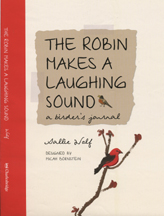 Chicago artist Sallie Wolf’s charming children’s book The Robin Makes a Laughing Sound (Charlesbridge, 2010) invites kids to get to know some of their noisiest neighbors – the birds! Young readers meet hungry baby starlings, strutting seagulls, a great horned owl, ruby red cardinals in the snow, and, of course, a laughing robin. The book’s design, by Micah Bornstein, is awesome. You feel like you’re standing right inside one of Sallie’s journals: warm water-colors, sketches, playful poetry, nature observations, and bird lists. She beautifully brings together her passion for birds and journaling. Great for kids 8 to 108.
Chicago artist Sallie Wolf’s charming children’s book The Robin Makes a Laughing Sound (Charlesbridge, 2010) invites kids to get to know some of their noisiest neighbors – the birds! Young readers meet hungry baby starlings, strutting seagulls, a great horned owl, ruby red cardinals in the snow, and, of course, a laughing robin. The book’s design, by Micah Bornstein, is awesome. You feel like you’re standing right inside one of Sallie’s journals: warm water-colors, sketches, playful poetry, nature observations, and bird lists. She beautifully brings together her passion for birds and journaling. Great for kids 8 to 108.
Here’s what Sallie Wolf had to say about The Robin Makes a Laughing Sound, writing, birding, laughing robins, and getting to know the world through your own eyes:
MGB: First things first: What is a birder?
SW: Good question. A birder is someone who is interested in birds, especially someone who watches the birds he or she sees outdoors. Some birders maintain feeders in their yards to encourage birds to come closer. Some birders make field trips to special places to see birds in their habitats—bald eagles along the Mississippi, or a trip to see Sandhill Cranes, for example.
MGB: What is fun about bird-watching? Why do you do it?
SW: When I moved from the East Coast to the Chicago area I moved from a semi-rural suburban setting with remnant woods and farms, winding roads, and hills to a flat, urban grid. Bird-watching in Chicago became a way of making Chicago and the Midwest my home. I put feeders in my back yard and I had goldfinches and chickadees and cardinals in the wintertime as well as the migrants passing through in the spring and fall. Birds became more and more important to me, reminding me that even in an extremely urban setting, Nature is at work. We are a part of Nature, no matter how we alter the environment.
MGB: How do you recommend someone start out bird-watching? Do you need special equipment to become a birder?
SW: The more you pay attention, the more birds you will find–in parks, sitting on wires, perched on chimneys or rooftops, pecking along the edge of the road, feeding in yards. If you put up a bird feeder and keep it supplied with bird seed you will attract more birds, though not necessarily more different kinds of birds. I have tons of house sparrows that eat me out of house and home. As I’ve altered my garden to include more native plants I’ve improved the diversity of birds in my yard.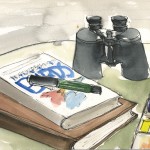
As you get more interested in birding you may want to buy a pair of binoculars to help you see birds who are too shy to come out in the open. A good field guide, such as the Peterson Field Guide, is helpful for learning to identify birds. I like to keep track of what birds I see in my journal, compiling a list each day. I do this to become familiar with what birds I might expect to see at what time of year.
MGB: What species can families look for in the Midwest?
SW: There are quite a few species in the Midwest, depending on the time of year and the habitat around you. Cardinals, crows, blue jays, starlings, pigeons, house sparrows, mourning doves have adapted to urban and suburban living quite well and are found year round. Gulls and Canada geese are also common. If there are big trees and some planted areas, chickadees and woodpeckers can be found. Other summer nesters are cat birds, chimney swifts, chipping sparrows, Coopers hawks, grackles, and many others. The spring migration brings a wide variety of warblers, sparrows, thrushes, and all sorts of birds moving through the Midwest. The junco comes to the Chicago area in the winter from its nesting areas in the far north and on mountain tops. There are hundreds of different species to be found in the Midwest if you know when and where to look.
MGB: What’s your favorite bird to watch? Why?
SW: This is almost like asking, “Which of your children do you like best?” But there are certain birds which I get a real kick out of. I love the juncos which come in the winter. They are very beautiful birds in an austere grey and white way–very elegant coloring. I also love the robins. They are the first bird I learned to identify. They signal that spring is really coming. They have a pretty song and interesting calls, such as the laughing sound which inspired the title of my book. Their eggs are a beautiful blue.
MGB: The Robin Makes A Laughing Sound shows journal entries where you’re trying to identify birds. How can you tell birds apart? What do you look for?
SW: It is helpful to learn which birds are likely to be in your area at which time. I learn this from looking at bird lists handed out by the Audubon Society or the Arboretum, some museums, or the Botanical Gardens. I also talk to other birders about what they are seeing. Size and silhouette are key to identifying birds. Is it bigger than a robin? Bigger than a crow? Small, like a sparrow?
Then you look for the most distinguishing marks–is the breast clear or striped? Does it have any stripes on its head or around its eye? Does it have wing bars? I’ll make a note of any identifying marks–a patch of white, a pattern of stripes on the head—and maybe sketch the bird in my journal. That helps me remember what I saw and sometimes I am able to figure out its name long after I saw it.
MGB: Your journal is full of questions like: “Do owls migrate?” and “where do birds sleep at night?” and “who made that sound?” Did you get answers to your questions?
SW: I may be better at asking questions than answering them. I checked the Peterson Field Guide to find out if owls migrate. The answer is some do and some don’t. I’m still not sure where birds sleep at night, once the eggs have hatched and the babies have left the nest. And as to who made that sound–I think it turned out to be a squirrel scolding me.
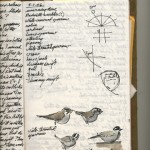 MGB: Your artwork shows a lot of birds and phases of the moon. How does observing nature inspire your creativity?
MGB: Your artwork shows a lot of birds and phases of the moon. How does observing nature inspire your creativity?
SW: One effect of drawing from observation is that my eyes get sharper and sharper at picking out details. I see things differently now than I did before I began to draw. I hope I am building a stronger visual memory. Before there were photographs, copying machines, TVs, and computers, before books were plentiful, drawing was the best way to convey what something looked like, and people’s visual memories were much stronger than today.
Another inspiration I get from nature has to do with color. Insects, birds, sea shells, fish, animals, and flowers have the most amazing color combinations. I have always been attracted to color and I love to observe and paint the patterns I see in Nature.
MGB: Some artists say that when they draw something, they “know” it better. Writers often feel the same way. How does drawing and journaling about birds make you feel and think about them?
SW: Over time I’ve begun to recognize shifts in behavior, so that not only can I recognize a bird, but I’m becoming tuned in to its life cycle—this must be courting behavior; or, I bet it has a nest and babies nearby; or, these birds are gathering together to migrate soon. My drawing and writing, my close observation, have taught me to trust my instincts. I can teach myself a lot just by paying close attention and spending time looking with my own eyes. I do not need a book or the internet to tell me everything.
MGB: Is there anything special you’d like readers to know about your work?
SW: I hope that when readers look at my book, The Robin Makes A Laughing Sound, their response will be something like, “I can do that!” Better still, maybe they’ll say, “I want to do that!” You can draw what you see and care about–it doesn’t have to be birds. You can make observations about what you are interested in. You can spend time letting your words and drawings grow in your journals. I have been drawing the same things over and over again for a long period of time. Just the way you get better and better at riding a bike the more you practice, you also get better and better at drawing, better and better at writing, better and better at seeing, even. It is the practice, not the end product, that is of value.
MGB: One final question: The title of your book is The Robin Makes A Laughing Sound. What is 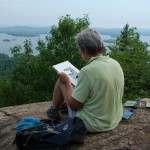 that sound?
that sound?
SW: Oooh–I wish I could write that sound. I can’t even make that sound. I was walking home one day and heard this noise. I stopped, looked up, searched a tree until I found the bird, a robin, which was making the sound. And then as I continued on my walk I began to think how could I describe that sound? It makes me think of my neighbor’s guinea pigs, the little, not quite squeaky sound they make. It makes me think of the word chuckle. Chortle? It is a quiet, subdued, repeated sound, not a song, not a whistle, that robins make to alert other birds.
As I walked I discovered the first line of the poem — “The robin makes a laughing sound.” The rhythm of that line matches the rhythm of my walking gait. I continued to compose the poem all the way home.
MGB: Thanks, Sallie, for your time, your art, and for sharing your birding and journaling tips!
Illustrations © 2010 by Sallie Wolf from The Robin Makes a Laughing Sound.
Honoring Our Ancestors
We were in Japan for 3 weeks this summer which was a wondrous journey of extremes: from the neon, buzz and bullhorns, and manga-mania of Electric Town in Tokyo to the mist-covered hills, sacred herd of deer, 1,000-year-old cedar tree, and the shrines and temples of Nara.
It’s taking a while to get back into the F L O W of home…though it is lovely to be someplace where I have mastery over the language!
But I came home to the August 2010 issue of Our Own Voice, a literary ezine of the Filipino diaspora. This special issue was edited by the dynamic Leny Strobel, director of the Center for Babaylan Studies and by OOV editor Aileen Ibardaloza-Cassinetto, poet of the exquisite. It is dedicated to exploring and celebrating babaylans, indigenous Filipino healers and shamans. The zine’s frontis piece took my breath away.
One of my own pieces, “Honoring Our Ancestors,” is included in this issue. (Note: It is not for the squeamish; I am unabashed about the mysticism. Read at your own risk.) I share my experience of attending the First International Babaylan Conference which happened last April. But, more importantly, the piece is about the tradition of staying connected to those who have gone before us. Mine is only one voice in this chorus, this chant. I am privileged to be in such company, especially Frances Santiago’s “Pintada,” M. Evelina Galang’s Lola Amonita Balajadia and the Counselors of Light,” and Leny’s From the Editors Laptop column. Check out the issue! (And if you do, try reading while listening to Grace Nono’s song “Panangpit.”)
Now that I’m back, there’ll be more coming in the blog…particularly around art that celebrates nature and encourages us all to connect…
Mabuhay, live,
Mary Grace
No Lights but our Own
The storm brought everyone outside: neighbors checking on each other, comparing notes, tsk-ing, and wondering at the downed trees, the debris-strewn street. I managed to sneak a post yesterday before ComEd shut everything down so they could address live wires and blown transformers. (Photos in yesterday’s post.)
ABC News reported that there were 215,000 Chicagoans without power this morning. I’ll tell you how we spent our evening. We’re one of the suburbs just west of Chicago. It was a very quiet night. With no electricity, there wasn’t the hum of the fridge or the roar of central air. I came inside and my husband had lit all the candles and wall sconces he could find in our teeny brick bungalow. It struck me…I’m so used to the noises inside my house — the whir of the laptops — it’s sort of a relief to hear the quiet in our home.
I pulled our boy outside with his harp thinking that our neighborhood might enjoy a little home-made music. So he sat in his jammies jammin on his harp. *lol* Our awesome next-door-neighbors came over and B. played his silver trumpet. A duet of trumpet and harp, two boys adding peace to the ragged edges of the storm. They played a little “Paruparong Bukid” (Filipino folk song), “Star Wars”, “A Whole New World”, and did a sweet duet of “Twinkle-twinkle Little Star”.
It was nice to hang out with our neighbors on our front stoop, enjoying our boys, and their music. Don’t get me wrong. I did worry about whether the lack of our sump-pump would flood our basement or if the food in the fridge would all go bad and whether the the temperatures would soar the next day leaving us trapped in an pressure-cooker of a house.
But the aftermath of the storm brought its pleasures, too. The quiet of the night. The boys’ music. Conversation with neighbors. A certain relaxed pace. I fell asleep to the voices of the men next door trying to figure out if they could get the garage door up and working.
Best line I heard yesterday, hands down, came from two boys cruising our hood on foot to take in the devastation:
Boy #1: “Whoooaaa! Look at that!” (He points to our neighbor’s house engulfed in tree limbs.)
Boy #2: “Told you. It’s better’n’cable!”
See what can happen when we’re unplugged?
~ MGB

